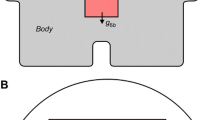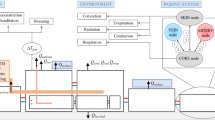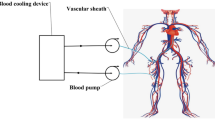Abstract
A new automatic air-cooling system is proposed using a cooling incubator to replace the manual water-cooling blanket which has traditionally been used to lower brain tissue temperature (BTT) in brain hypothermia treatment (BHT). This study concerns its feasibility through a simulation. First, a biothermal model is proposed for the adult incubating system based on the geometric structure and parameters of patients. Its dynamics were carefully examined by two simulation experiments testing its step response and feedback control. Then a model reference adaptive control algorithm was introduced for the automatic regulation of BTT, where the newly developed adult incubating biothermal model, represented by a state equation, was replaced for the hypothermic patient with a cooling blanket, thus introducing a first-order lag system given as its basic characteristic model. Finally, the proposed cooling incubator was controlled by the adaptive control mechanism, which gives a follow-up of BTT to a given reference temperature course, even if a possible environmental change in the therapeutic cooling system exists, including the individual differences of patients and any chronic conditional change. The automatic cooling incubating system based on the air-cooling method was confirmed to be superior to the water-cooling one. Thus, this work supports the possible development of an air-cooling adult incubating system for the automatic regulation of BTT in an intensive care unit (ICU) application.
Similar content being viewed by others
References
N Hayashi (1995) Cerebral hypothermia treatment (in Japanese) N Hayashi (Eds) Cerebral hypothermia treatment Sogo Igaku Tokyo 1–105
N Hayashi (2000) The clinical issue and effectiveness of brain hypothermia treatment for severely brain-injured patients N Hayashi (Eds) Brain hypothermia Springer Tokyo 121–151
T Obashi M Fukushi N Umeno et al. (1998) Nursing in brain hypothermia treatment (in Japanese) T Yamamoto A Teramoto (Eds) Brain hypothermia treatment Herusu Press Tokyo 124–146
K Takahara H Wakamatsu (1993) ArticleTitleControl of artificial respiration by an adaptive pole-placement method (in Japanese) J EIC J76-D-II 2126–2132
Takahara K, Wakamatsu H (1997) Human friendly control system of alveolar CO2-concentration based on adaptive control theory. Proceedings of the 6th International Workshop on Robot Human Communication, Sendai pp 432–437
Takahara K, Wakamatsu H, Miyazato I (1999) Adaptive control of artificial ventilation for respiratory failure patients. Proceedings of the European Control Conference (ECC'99) Springer-Verlag, London, F373, pp 1–6
H Xu H Wakamatsu S Kagei et al. (1996) ArticleTitleControl of artificial respiration with regard to differences of individuals using a fuzzy algorithm (in Japanese) IEEJ Trans EIS 116 472–478
Wakamatsu H, Takahara K (1997) Human-friendly clinical control of respiration to deal with differences of individual characteristics. Proceedings of the 6th IFAC Symposium, Automated Systems based on Human Skill. Kristoff s.p., Ljubljana pp 73–76
Wakamatsu H, Takahara K (1999) Automatic control of respiration to deal with differences of individual characteristics. Proceedings of the IFAC 14th World Congress, Biomedical Control L. Pergamon, Oxford, pp 17–22
Wakamatsu H, Lu Gaohua (2002) Model reference adaptive control of brain temperature for cerebral hypothermia treatment. Proceedings of the 5th Asia–Pacific Conference on Control Measurement (APCCM2002), China Aviation Industry Press, Nanjing, pp 1–6
D Fiala KJ Lomas M Stohrer (1999) ArticleTitleA computer model of human thermoregulation for a wide range of environmental conditions: the passive system J Appl Physiol 87 1957–1972
Z Lou WJ Yang (1990) ArticleTitleWhole body heat balance during human thoracic hyperthermia Med Biol Eng Comput 28 171–181
A Shitzer RC Eberhart (1985) Heat generation, storage, and transport processes A Shitzer RC Eberhart (Eds) Heat transfer in medicine and biology: analysis and applications Plenum Press NewYork 137–152
JAJ Stolwijk JD Hardy (1966) ArticleTitleTemperature regulation in man: a theoretical study Pflugers Arch 291 129–162 Occurrence Handle10.1007/BF00412787
J Werner M Buse (1988) ArticleTitleTemperature profiles with respect to inhomogeneity and geometry of the human body J Appl Physiol 65 1110–1118
J Werner P Webb (1993) ArticleTitleA six-cylinder model of human thermoregulation for general use on personal computers Ann Physiol Anthrop 12 123–134
Lu Gaohua H Wakamatsu (2003) ArticleTitleStudy on control of brain temperature for brain hypothermia treatment (in Japanese) IEEJ Trans EIS 123 1393–1401 Occurrence Handle10.1541/ieejeiss.123.1393
AS Iberall AM Schindler (1973) ArticleTitleOn the physical basis of a theory of human thermoregulation. Trans ASME J Dynamic Syst Measurement Control 95 68–75
JG Stone WL Young CR Smith et al. (1995) ArticleTitleDo standard monitoring sites reflect true brain temperature when profound hypothermia is rapidly induced and reversed? Anesthesiology 82 344–351
DKC MacDonald CH Wyndham (1950) ArticleTitleHeat transfer in man J Appl Physiol 3 342–364
O Plattner A Kurz DI Sessler et al. (1997) ArticleTitleEfficacy of intraoperative cooling methods Anesthesiology 87 1089–1095
H Wakamatsu Lu Gaohua (2003) ArticleTitleBiothermal model of a patient and an automatic control system of brain temperature for brain hypothermia treatment (in Japanese) IEEJ Trans EIS 123 734–741
H Wakamatsu Lu Gaohua (2003) ArticleTitleAutomatic adaptive control system of brain temperature for brain hypothermia treatment (in Japanese) Brain Death Resuscitation 15 25–33
D Fiala KJ Lomas M Stohrer (2001) ArticleTitleComputer prediction of human thermoregulatory and temperature responses to a wide range of environmental conditions Int J Biometeorol 45 143–159 Occurrence Handle10.1007/s004840100099
Stolwijk JAJ, Hardy JD (1977) Control of body temperature. In: Handbook of physiology. Reactions to environmental agents. Am Physiol Soc, Bethesda, Sect 9, Part 1, Chap 4, pp 45–68
H Wakamatsu Lu Gaohua (2003) ArticleTitleBiothermal model of a patient for brain hypothermia treatment (in Japanese) IEEJ Trans EIS 123 1537–1546
AJ Gunn PD Gluckman TR Gunn (1998) ArticleTitleSelective head cooling in newborn infants after perinatal asphyxia: a safety study Pediatrics 102 885–892
MR Battin JA Dezoete TR Gunn et al. (2001) ArticleTitleNeurodevelopment outcome of infants treated with head cooling and mild hypothermia after perinatal asphyxia Pediatrics 107 480–484 Occurrence Handle10.1542/peds.107.3.480
Author information
Authors and Affiliations
Corresponding author
About this article
Cite this article
Wakamatsu, H., Gaohua, L. Automatic optimal-adaptive air-cooling system for brain hypothermia treatment. Artif Life Robotics 9, 209–221 (2005). https://doi.org/10.1007/s10015-005-0348-6
Received:
Accepted:
Issue Date:
DOI: https://doi.org/10.1007/s10015-005-0348-6




